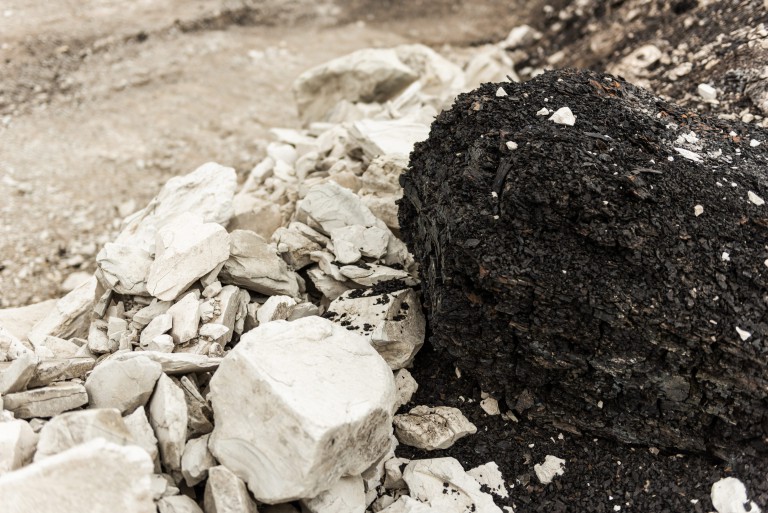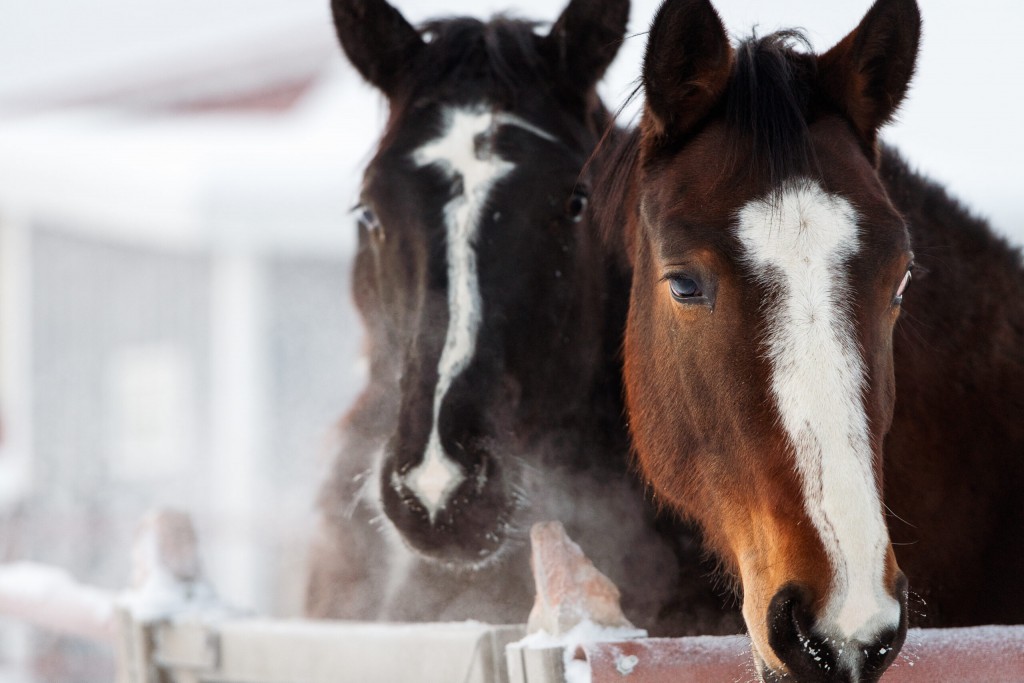 COZY HORSE BLANKET
COZY HORSE BLANKET
To ensure a horse will be comfortable outside in cold climates, they should be healthy and have a thick, dry and clean hair coat. Healthy horses develop natural winter coat as the days become shorter and temperatures become colder.
Blanketing a horse may be necessary when no shelter is available and temperatures or wind chill drops below 5 F (-15 C).
If a horse is blanketed, it is critical that you have a properly fitted blanket for your horse. When the blanket does not fit properly it can lead to sores and rub marks, especially along the straps. When your horses are wearing a blanket, it is important to remove the blanket daily, and inspect your horse for rub marks, and sores. Adjust the blanket accordingly to reduce any rub marks. Ensure that your horse is dry before putting a blanket on.
Another time when it may become necessary for a horse to wear a winter blanket is when the horse has had its winter coat clipped, when the horse is young or older, and when the horse hasn’t had the opportunity to acclimatize to the cold weather.
You will also need to consider the health and body condition of your horse. It is a good idea to blanket your horse during the cold weather if the body condition score of your horse is 3 or less.COZY
 FRESH WATER
FRESH WATER
A horse can easily become dehydrated in the cold weather when it does not have access to fresh or unfrozen water. Horses that do not have access to water can quickly start to lose body weight and show symptoms of dehydration. Symptoms may include dry mucous membranes, sunken eyes, slow capillary refill, tucked up appearance and loss of elasticity in skin. The horse will also start reducing feed intake and may ultimately refuse to eat.
A heated water bucket, heater in water troughs, and a heated automatic watered are options to provide unfrozen water. Without heaters, make sure the ice is broken on the horse’s water supply. When you are using a submergible electric water heater in a water trough, you will need to check daily to ensure the heating element is on and there is no stray voltage.
You may find that some horses do not like the water heaters and prefer to have a fresh bucket of water offered to them.
 SHELTER
SHELTER
Horses can withstand significant drops in temperature provided they have some protection from the wind and wet (rain/sleet) conditions. Snow is tolerated much better than rain and sleet with the insulation of a healthy winter coat. Unfortunately not much helps with keeping your horse comfortable during rainy weather or sleet. When rain and sleet wets the hair down the insulating capacity of the coat is less effective. Wind chills coupled with a wet coat can lead to the potential of hypothermia.
Sheltering a horse during times of rain or sleet is the best option to keep your horse safe. A full barn is not required to shelter your horse. You can use for a tree line wind break, a three sided shed or an enclosed barn and stalls that may or may not be heated.
For enclosed barns, it must be adequately ventilated to prevent respiratory issues. Proper ventilation will help to prevent the accumulation of ammonia and mold levels. as well as help to reduce humidity and moisture levels.
Considerations when using a three sided shed with a group of horses:
- adequate size – 12×20 feet with horses that get along
- each additional horse needs an additiona 6×10 feet
- the size of the horse may require less or more space
- regular cleaning routine
Establishing a regular routine, while using the proper tools when cleaning the stalls will make winter stall maintenance an easier task. Each type of bedding has advantages and disadvantages. The primary purpose of bedding is to absorb urine and moisture. Other considerations include:
- space available to shelter your horse
- dust and allergies
- waste disposal
- availability
- cost and effectivness
BEDDING OPTIONS
Cleaning
The best time to muck out a stall is when it is empty. Use a pitchfork to remove any large piles of manure. Gently shake the pitchfork or toss it to allow the clean shavings to drop back onto the stall floor. This will help to reduce losing too many shavings that are still good to use. Rake up and push the wet shavings into a pile, making sure that you rake down to the down to the stall floor. Take extra care to rake the shavings from the sides and corners. Leaving wet shavings behind can lead to an accumulation of ammonia levels from the urine left behind. Leave the wet floor area uncovered. Sprinkle with Stall DRY to absorb moisture and odors. .The remaining shavings that are starting to become darker in color can be moved to where the horse’s urine area of choice is so that these shavings can absorb the urine instead of the newer, fresher shavings. Take care to replace any shavings that show signs of mold or are showing significant signs of dust.
Level out the shavings and add a fresh layer on top as is required. Sprinkle an additional layer of the stall absorbent and deodorizer over your layer of fresh bedding.
A sprinkle of Stall DRY will help to reduce the ammonia levels in your bedding waste collection area, which also leads to reducing the accumulation of flies, and nasty odors.
Pros
- pleasing smell of pine or fir
- kiln-dried better then chip-like shavings
- purchase in bulk
Cons
- not very absorbent
- dusty
- potential fire hazard
- extra care in keeping dust and cobwebs to a minimum
- takes more time to clean then shavings or wood pellets
Cleaning
Stalls bedded with wood pellets do not need to be cleaned the same way as with traditional shavings. Cleaning works best in stalls that use rubber mats. The best time to muck out a stall is when it is empty. The horses will naturally break down the wood pellets into sawdust. Use a slotted fork to remove the manure, but take out as little of the bedding as possible. For urine remove the saturated areas and sprinkle the damp area with Stall DRY to absorb moisture and odors. .Remix the damp bedding with dry bedding until it appears dry.
An sprinkle of Stall DRY will help to reduce the ammonia levels in your collection area, which also leads to reducing the accumulation of flies, and nasty odors..
Pros
- made of kiln-dried wood
- available in fir, alder or pine, sawdust
- low in dust
- highly absorbent
- composts well
- easy to clean up manure and urine
- cost effective
Cons
- may not absorb moisture as well in cold weather
Cleaning
The best time to muck out a stall is when it is empty. Pick out manure and soiled straw with a metal pitchfork and place it in a pile. Check for additional manure or soiled straw by moving the clean straw to the corners of the stall with a pitchfork or rake. Allow the ground to dry. Sprinkle the exposed stall floor with Stall DRY on the wet areas to absorb moisture and odors. Spread the remaining clean straw over the stall floor and add additional bedding as required.
For spot cleaning, pick out manure and soiled straw with a metal pitchfork. Sprinkle wet bedding with an absorbent deodorizer.
The soiled straw and manure can be placed in a collection area that can be later collected and used by mushroom farmers.
A sprinkle of Stall DRY will help to reduce the ammonia levels in your collection area, which also leads to reducing the accumulation of .flies, and nasty odors.
Pros
- Manure and urine settles to bottom creating a type of barrier
- low cost option depending on availability
- composts well
Cons
- requires ample room for storage
- require around 5 bales per horse per week
- potential for accumulation mold and ammonia due to low absorbency
- dusty
Pros
- provides a cushioning effect
- level surface
- easily scoop manure and soiled bedding
- reduce amount of bedding required
- reduced stall waste
- less storage space needed for bedding
- can use in combination with wood pellets or shavings
- makes stall cleanup easier when using other bedding
- inital investment is pricey


